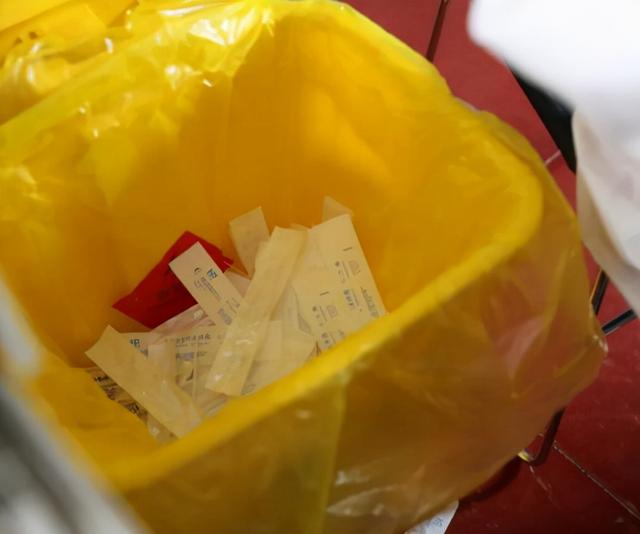अस्पतालों में, फाहे नमूना संग्रह के लिए एक महत्वपूर्ण उपकरण हैं, संक्रमण नियंत्रण, और नैदानिक परीक्षण. हालाँकि, स्वाब अपशिष्ट प्रबंधन एक जटिल मुद्दा है जिसे स्वास्थ्य देखभाल सुविधाओं को पर्यावरणीय स्थिरता और रोगी सुरक्षा दोनों सुनिश्चित करने के लिए संबोधित करना चाहिए. संदूषण को कम करने और संक्रमण के प्रसार को रोकने के लिए स्वाब और अन्य चिकित्सा कचरे का निपटान सख्त दिशानिर्देशों द्वारा नियंत्रित किया जाता है. यहाँ इस बात का अवलोकन है कि कैसे अस्पताल स्वैब कचरे का प्रबंधन करते हैं:

उचित स्वैब निपटान का महत्व
स्वैब, कपास की झाड़ू सहित, फोम स्वैब, और झूलता हुआ स्वैब, चिकित्सा प्रक्रियाओं की एक विस्तृत श्रृंखला में उपयोग किया जाता है. उपयोग के बाद, वे अक्सर शारीरिक तरल पदार्थ से दूषित होते हैं, रोगज़नक़ों, या रसायन. स्वैब कचरे के अनुचित निपटान से क्रॉस-संदूषण हो सकता है, संक्रमण का प्रसार, और पर्यावरणीय खतरे. अस्पतालों को सुरक्षित हैंडलिंग सुनिश्चित करने के लिए स्वास्थ्य अधिकारियों और पर्यावरण संरक्षण एजेंसियों द्वारा स्थापित दिशानिर्देशों का पालन करना चाहिए, निपटान, और इन सामग्रियों का पुनर्चक्रण.
कदम 1: चिकित्सा अपशिष्ट को वर्गीकृत करना
स्वैब कचरे के प्रबंधन में पहले कदम अस्पतालों में से एक कचरे को सही ढंग से वर्गीकृत कर रहा है. स्वैब अपशिष्ट की श्रेणी के अंतर्गत आता है “विनियमित चिकित्सा अपशिष्ट” (आरएमडब्ल्यू) संक्रमण के लिए इसकी क्षमता के कारण. चिकित्सा अपशिष्ट को आमतौर पर निम्नलिखित श्रेणियों में वर्गीकृत किया जाता है:
- संक्रामक अपशिष्ट: इसमें उन स्वैब शामिल हैं जो नमूना संग्रह या घाव की देखभाल के लिए उपयोग किए गए हैं और शारीरिक तरल पदार्थ या रोगजनकों से दूषित हैं.
- शार्प्स वेस्ट: हालांकि स्वैब स्वयं तेज नहीं हैं, वे सुइयों या अन्य तेज वस्तुओं से दूषित हो सकते हैं और तदनुसार निपटान किए जाते हैं.
- अचूक अपशिष्ट: कुछ स्वैब गैर-संक्रामक पदार्थों से दूषित हो सकते हैं और उन्हें गैर-खतरनाक के रूप में वर्गीकृत किया जाता है.
कचरे को ठीक से वर्गीकृत करके, अस्पताल सुनिश्चित करते हैं कि प्रत्येक प्रकार के कचरे को उचित तरीके से निपटाया जाता है.
कदम 2: सुरक्षित निपटान और अलगाव
एक बार स्वैब कचरा एकत्र किया जाता है, इसे रंग-कोडित में अलग किया जाता है, लीक-प्रूफ कंटेनर जो चिकित्सा अपशिष्ट के लिए स्थानीय नियामक आवश्यकताओं का पालन करते हैं. अधिकांश अस्पतालों में, एक तीन-स्तरीय अपशिष्ट अलगाव प्रणाली का उपयोग किया जाता है:
- लाल बिन्स: संक्रामक कचरे के लिए, जैसे कि वायरस या जीवाणु संक्रमण के लिए परीक्षण में उपयोग किए जाने वाले स्वैब.
- पीले रंग के डिब्बे: सामान्य चिकित्सा कचरे के लिए जो संक्रामक नहीं हो सकता है लेकिन फिर भी देखभाल के साथ संभाला जाना चाहिए.
- शार्प कंटेनर: इस्तेमाल की गई सुइयों और तेज वस्तुओं के लिए जो स्वैब के संपर्क में थे.
रिसाव को रोकने और संक्रमण के जोखिम को कम करने के लिए प्रत्येक अपशिष्ट कंटेनर को कसकर सील कर दिया जाता है. अस्पताल भी विशेष का उपयोग करते हैं, Biohazard बैग में उपयोग किए जाने वाले स्वैब और अन्य अपशिष्ट पदार्थों को शामिल करने के लिए वे निपटान क्षेत्रों में ले जाया जाए.
कदम 3: उपचार और निपटान विधियाँ
स्वैब कचरे को आमतौर पर निष्फल किया जाता है और यह सुनिश्चित करने के लिए इलाज किया जाता है कि यह किसी भी संक्रामक एजेंटों से मुक्त है. चिकित्सा अपशिष्ट के इलाज के लिए दो मुख्य तरीके हैं:
- वाष्पदावी: संक्रामक कचरे के इलाज के लिए सबसे आम विधि, ऑटोक्लेविंग कचरे को निष्फल करने के लिए दबाव में भाप का उपयोग करता है. उच्च गर्मी यह सुनिश्चित करती है कि अंतिम निपटान के लिए भेजे जाने से पहले स्वैब पर कोई भी रोगजनकों को नष्ट कर दिया जाता है.
- भस्मीकरण: कुछ मामलों में, हानिकारक सूक्ष्मजीवों के पूर्ण विनाश को सुनिश्चित करने के लिए चिकित्सा अपशिष्ट उच्च तापमान पर उकसाया जाता है. यह विधि कचरे के लिए विशेष रूप से प्रभावी है जिसे ऑटोक्लेव नहीं किया जा सकता है.
नसबंदी के बाद, उपचारित कचरे को एक लैंडफिल या रीसाइक्लिंग सुविधा के लिए भेजा जाता है, कचरे की प्रकृति पर निर्भर करता है. अस्पताल तेजी से पर्यावरण के अनुकूल प्रथाओं को अपना रहे हैं, जैसे कि वे उत्पन्न करने वाले गैर-पुनर्नवीनीकरण अपशिष्ट की मात्रा को कम करना, और कुछ स्वैब को नसबंदी के बाद पुनर्नवीनीकरण किया जा सकता है.
कदम 4: पुनर्चक्रण और स्थिरता
हाल के वर्षों में, कई अस्पतालों ने अधिक टिकाऊ अपशिष्ट प्रबंधन प्रथाओं की ओर रुख किया है, रीसाइक्लिंग और कुछ चिकित्सा वस्तुओं को पुन: व्यवस्थित करना शामिल है. जबकि स्वैब का पुनर्चक्रण स्वयं संदूषण के कारण संभव नहीं हो सकता है, स्वैब कचरे से जुड़ी कुछ सामग्री, जैसे पैकेजिंग और प्लास्टिक के घटक, पुनर्नवीनीकरण किया जा सकता है. अस्पताल अपने पर्यावरणीय प्रभाव को कम करने के लिए अपशिष्ट-से-ऊर्जा प्रौद्योगिकियों और स्थायी निपटान विकल्पों में निवेश कर रहे हैं.
इसके अतिरिक्त, चिकित्सा निर्माता गैर-पुनर्निर्माण योग्य कचरे की मात्रा को कम करने के लिए बायोडिग्रेडेबल या पर्यावरण के अनुकूल सामग्री से बने स्वैब और अन्य उपभोग्य सामग्रियों का उत्पादन कर रहे हैं. अस्पताल इन्वेंट्री प्रबंधन को अनुकूलित करके और एकल-उपयोग स्वैब के अनावश्यक उपयोग को कम करके अपने पर्यावरणीय पदचिह्न को भी कम कर सकते हैं.
कदम 5: कर्मचारी प्रशिक्षण और अनुपालन
प्रभावी अपशिष्ट प्रबंधन अच्छी तरह से प्रशिक्षित स्वास्थ्य सेवा कर्मचारियों के साथ शुरू होता है. अस्पताल चिकित्सा अपशिष्ट के हैंडलिंग और निपटान में शामिल सभी कर्मियों के लिए प्रशिक्षण प्रदान करते हैं, यह सुनिश्चित करना कि वे सुरक्षा प्रोटोकॉल और उचित अपशिष्ट अलगाव के महत्व को समझते हैं. अस्पताल भी स्थानीय का अनुपालन करते हैं, राज्य, और संक्रामक रोगों और पर्यावरणीय संदूषण के संपर्क के जोखिम को कम करने के लिए राष्ट्रीय नियम.
निष्कर्ष
अस्पतालों को सार्वजनिक स्वास्थ्य और पर्यावरण दोनों की रक्षा के लिए सावधानीपूर्वक स्वैब कचरे का प्रबंधन करना चाहिए. वर्गीकृत करने के लिए सख्त प्रोटोकॉल का पालन करके, के निपटान, और चिकित्सा अपशिष्ट का इलाज करना, हेल्थकेयर सुविधाएं SWAB निपटान से जुड़े जोखिमों को कम करती हैं. चूंकि अस्पताल स्थिरता को गले लगाना जारी रखते हैं, अपशिष्ट प्रबंधन प्रथाएं स्वास्थ्य सेवा की जरूरतों और पर्यावरणीय लक्ष्यों को पूरा करने के लिए विकसित होगी.

















